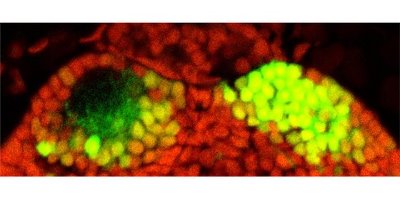Mar. 23, 2007 Research Highlight Biology
Timing is everything
New work sheds light on the processes determining brain asymmetry
 Figure 1: Cross-section of the habenulae of a zebrafish larva. Devel. Cell/ Elsevier/ 12/ 88 (2007)
Figure 1: Cross-section of the habenulae of a zebrafish larva. Devel. Cell/ Elsevier/ 12/ 88 (2007)
A recent study identifies one way in which brain asymmetry is generated. No one knows why many vertebrates contain asymmetrical brains. Some think it might allow multi-tasking. For example, while the left side is processing speech, the right side could be recognizing a face. Regardless, even less is known about the events responsible for this asymmetry.
A team led by Hitoshi Okamoto, a scientist at the RIKEN Brain Science Institute in Wako, uncovered one factor influencing asymmetrical formation of a region of the brain called the habenulae, which influences behaviors such as smell, appetite, and mating. The team's work was recently published in Developmental Cell 1.
The habenulae contain left and right nuclei, each of which can be populated by one of two types of subnuclei, lateral or medial. Each of these subnuclei contains nerve cells displaying distinct characteristics. Lateral subnuclei in the left side of the habenulae contain larger numbers of nerve cells than those on the right side, and vice versa for the medial subnuclei (Fig. 1). Thus, the researchers hypothesized that habenular asymmetry might be caused by asymmetries in the way these distinct varieties of nerve cells develop.
The researchers tracked nerve cell development in zebrafish, which have simpler brains than mammals and are easy to manipulate. Nerve cells exhibiting features of those in lateral subnuclei were ‘born’ earlier during development than medial subnuclei type nerve cells.
To determine whether birth date influences lateral versus medial nerve cell fate, the researchers manipulated signaling through a receptor called Notch, which regulates nerve cell development. Early Notch hyperactivity, which permitted only a quick burst of early nerve cell development, resulted in an increase in the number of lateral nerve cells on both sides of the habenulae. Likewise, Notch inhibition, which delayed nerve cell development until a late stage, favored development of medial nerve cells.
These data suggest that the left habenulae might provide nerve cell differentiation cues earlier than the right habenulae. Identification of these putative cues remains for future investigation.
“The nerve cells of the medial and lateral subnuclei are separately and indirectly connected with the region of the brain that regulates various states of mind, such as motivation, attention, awareness and fear,” explains Okamoto. “Therefore, this new information about the asymmetry in the sizes of the habenular subnuclei may shed light on the biological basis for functional brain asymmetry in the process of emotion and behavior.”
References
- 1. Aizawa, H., Goto, M., Sato, T. & Okamoto, H. Temporally regulated asymmetric neurogenesis causes left-right difference in the zebrafish habenular structures. Developmental Cell 12, 87–98 (2007). 10.1016/j.devcel.2006.10.004
